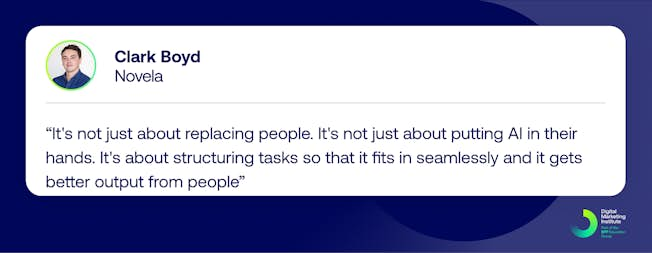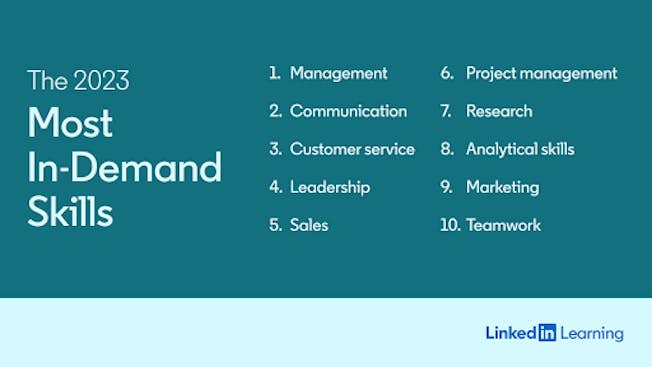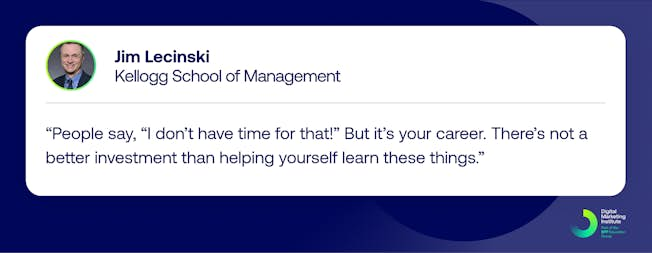Jan 9, 2024
What 8 Skills Do Marketers Need to Use AI Effectively?
For some marketers, the rise of artificial intelligence (AI) fills them with excitement as their minds race with the phenomenal possibilities of the technologies for business. For others, the rise of AI is something to fear.
We’ve already seen the benefits of AI in digital marketing. It can take over menial or repetitive tasks, it can drive automation and personalization, and it can help you get valuable insights into customers. But there are also disadvantages such as security risks, ethical considerations, and, most importantly, job displacement.
Marketers who want to thrive in this new age need to understand one thing - you must learn the skills required to work with AI or fill the gaps that it can’t.
12 Ways Digital Marketers Can Use ChatGPT
FACT: When we asked our 200k+ LinkedIn followers what the most important trend will be in 2024, 62% answered AI in marketing skills.
Below are eight key skills that are required to help marketers thrive in the age of AI. And we'll give you tips on how to upskill in the age of AI.
- Knowledge of ChatGPT
- Content creation and generation
- Data analysis
- Marketing automation
- Experience of AI tools and platforms
- SEO
- Soft skills
- Data privacy and ethical AI

1. Knowledge of ChatGPT
While AI has been around for a while in the background, what changed the game is ChatGPT.
Beneath all the hype, ChatGPT is an AI system based on a generative language model used to engage in conversations, gain insights, and automate tasks. While the technology only hit the mainstream in November 2022, countless people are already using it for various tasks, from ideation to content creation and analysis.
“You might type something in ChatGPT today and not be too impressed by the answer. However, tomorrow, ChatGPT will be twice as good tomorrow. And it’ll be four times better the next day! That’s how fast things move in this sphere,” Jim Leckinski, Kellogg School of Management
The important thing to remember about about ChatGPT is that it forms the basis for many future AI technologies. For example, image generator DALL-E 3 is built natively on ChatGPT and has evolved so you don't need to use prompt engineering - a task that confuses many marketers.
As AI technology continues to evolve, so will the platforms and their abilities. So ChatGPT is a great place to start in terms of using generative AI technology and understanding what it can do and how.
Learn more: Watch our video on how to get started with ChatGPT and download our Guide to ChatGPT Prompting for your digital marketing plan.
2. Content Creation & Generation
It's understandable that content marketers and designers would be worried about AI. After all, AI can generate content quickly and easily based on simple text prompts for both written content and imagery.
But content creation isn’t just about gathering and curating content that’s already out there. It’s about being creative. It’s about including a human perspective. It’s about collaboration and thinking outside the box.
Look at it from this perspective, AI can help you with your content creation. It can help drive content ideation, help find suitable keywords, or kickstart a blog introduction you’re having trouble with. It can also help to generate content for time-consuming tasks and free you up for more creative and enjoyable endeavors.
In 2024, generative AI technologies can help you with a range of tasks:
- Blog writing
- Sales writing
- Social media marketing
- Email marketing
- Image creation
- Content ideation
- Video production
- Influencer marketing
Whatever you need to use it for, AI should be part of your content creation strategy and process. You need to learn how to make the most of it and use data to feed into it to attract high-intent customers. Check out some great examples of brands using AI in their marketing to optimize campaigns.
The more you know about AI, the more you will get out of it. A good understanding will also ensure you stay competitive when it comes to that promotion or job opportunity.
“People are using AI because it's lower cost and highly scalable. But if you don't have a good creative platform and it doesn't come from creative and data-driven insights, then it's just spray and pray really,” Mischa McInerney, CMO of the Digital Marketing Institute
3. Data Analysis
Most businesses aim to make more of their data. A report by Pecan AI found that more than four out of five marketing executives find it difficult to make data-driven decisions, while 84% say their ability to predict consumer behavior feels like guesswork.
Understanding your data means you can gain insights that help you learn more about your customers and ensure you design a user interface or campaign that delivers. It’s also about analyzing data at scale and quickly to get meaningful results that allow customer-based predictions.
AI enables you to put all data into the mix - not just what you get from GA4 - such as reviews, forums, and social media posts to get an idea of what your customers are saying. And text analytics can give insight into customer sentiment, discussions, and conversation trends.
If you want to successfully implement AI, you need to develop your data analysis skills. The more you develop these skills, the better you’ll be able to grasp the insights that AI can deliver. This involves honing your expertise in the following areas:
- Data collection
- Data visualization
- Data cleaning and management
- Data-driven decision-making
- Data protection and privacy
These data skills are critical for enabling you to set up and operationally deploy the AI systems that you need.

4. Marketing Automation
AI and automation go hand in hand. These types of automation tools can help you identify the best channels, platforms, and times to reach your target audience and enable you to do it at scale, quickly.
You can use automation for a wide range of marketing activities such as:
- Email marketing: Create triggered workflows and drip campaigns, segment audiences into lists, and drive personalization through insights.
- Lead generation: Find and nurture customers and segment your traffic for greater personalization.
- Social media: Use chatbots to respond to messages, schedule social posts across channels, and track social conversations.
- Content creation: Get ideas for content and generate compelling marketing content based on input parameters including style, tone, and subject matter for a range of formats.
- Performance indicators: Track the success of your campaigns by plugging in the most relevant and important metrics.

According to Salesforce, 97% of global workers say they believe that businesses should prioritize AI in their employee development strategy.
5. Experience of AI Tools & Platforms
Although AI may seem daunting at first, marketers simply must develop a basic understanding of the AI tools and platforms out there. Many of these tools can help make your day-to-day job easier and take over tasks that consume a lot of time and energy, such as:
- Audience research
- Customer journey mapping
- Idea generation and content research
- Keyword research
- Trend analysis and forecasting
- Competitor monitoring
- Sales automation
- Social media management and advertising
- Writing and content generation
For example, Clearscope helps with keyword research and integration, TrendKite alerts you to upcoming trends, Outreach transforms sales data into actionable insights, CaliberMind augments B2B sales, and Market Brew reveals data for your SEO strategy.
“AI can be a very technical and complicated field. But you have to take the time to learn about it. Block off time each day to learn something new. Read, learn, watch, listen, talk to people and try to understand where things are and where they are going.” Jim Leckinski
6. SEO
Search engine optimization (SEO) is a fundamental part of any marketing team’s activities. By gaining an understanding of what people are looking for in search engines, brands can craft content that meets people’s needs and turns up higher in search results.
However, the SEO landscape is changing. Google relies on algorithms that crawl and index pages and rank them based on EEAT (Experience, Expertise, Authoritativeness, and Trustworthiness). But AI is continuously being used to improve these processes and algorithms to make search results more accurate, comprehensive, and personalized.
Google’s Search Generative Experience (SGE) may be still in an experimental phase (as of early 2024), but it’s already shaking things up and has the potential to affect clickthrough rates.
When you enter a query into SGE, you get a ‘snapshot’ with several elements:
- Generative answer
- Website carousel
- Follow-up questions
- Follow-up suggestions

To help with SEO, marketers can use AI tools to identify high-impact keywords and predict keyword trends. You can use several tools to help including MarketMuse, Ahrefs, SurferSEO, and SEMrush.
Learn more: For more in-depth information and tips in the area of SEO and SGE, check out our Digital Marketing Trends in 2024.
“As Google continues to provide strong answers to the most complex searches, your head terms will start to decrease in search volume as people increase long tail, complicated searches” Nikki Lam, Senior Director, SEO at Neil Patel Digital
7. Soft Skills
While technical skills (also known as ‘hard skills’) are a must-have for marketers, in recent years employers have highlighted the need for soft skills. In this new age of AI in marketing, the need is greater than ever for professional skills that will complement your digital and technical skills.
Soft skills (also known as power skills) are important to employers because they are personal traits and behaviors that are developed through life experiences. These skills can positively and negatively impact the way someone goes about their work.
LinkedIn Learning’s list of the most in-demand skills shows the appetite for soft skills such as communication, leadership, and teamwork.

Other soft skill areas that are important include:
- Strategic thinking: This enables you to take a long-term view of complex business scenarios and develop tactics to achieve business goals and objectives.
- Creativity: A willingness to innovate helps generate new ideas or come up with innovative spins on tired campaigns.
- Agility: Take a flexible approach to projects and be willing to unlearn what you 'know' and make mistakes. However, then remember to learn from them!
- Collaboration: Our recent member survey discovered that collaboration was a top skill to hone. This enables teamwork, building relationships, and resolving conflicts.
- Willingness to learn: Learning is crucial for career development. A willingness to learn demonstrates a thirst for knowledge and a desire to be better in a role.
Top tip: One way you can use AI to nudge your creativity is by developing a good understanding of the key AI algorithms. This will enable you to see opportunities for innovation while helping you guard against any potential risks.
8. Data Privacy & the Ethics of AI
The age of AI brings risks. Because it is a generative technology, there’s the potential for misinformation, plagiarism, and harmful content, along with a lack of transparency and job displacement. All areas of industry are learning to deal with the effects of AI, from publishing and entertainment to medical and manufacturing, with ongoing litigation against key AI companies set to increase during 2024, such as a potential landmark case from the New York Times.
As a result of the rise in AI and automation, Salesforce research found that 60% of leaders believe data security skills and 58% believe ethical skills will become increasingly important in the workplace.
Marketers have access to a lot of customer data, and AI platforms are already used widely to gather and sort information through chatbots or automation. This has ethical implications and can lead to issues with data privacy if customers are tracked using AI without consent or if bias occurs due to poor or misrepresented data.
So it’s important for marketing teams to be transparent about their use of AI and in the collection and processing of personal data. Companies should ensure their systems are secure, private, and non-discriminatory.
Read more: listen to Sean Falconer of Skyflow on the DMI podcast on issues of data privacy within the AI landscape.
“I predict in 2024 we're going to come over the hype cycle and the real work in generative AI is going to start where real projects will have meaningful impact to people's lives.” Sean Falconer, Skyflow
How to Upskill in the Age of AI
People are inevitably concerned about job security in the age of AI. After all, many manual and labor-intensive marketing tasks will soon be done by AI - if they aren’t already. So how can you safeguard and develop your marketing career?
Awareness: The first step to protecting your career is to become aware of how the industry is changing. Take time to learn about the latest developments, trends, and tools so you can stay relevant.
Action: Use knowledge to determine your next steps. Are you going to sit on the sidelines and let these changes roll over you? Or are you going to dive in with two feet and try to understand what’s going on and learn how you can keep up?
Application: What can you do with this new knowledge? Apply what you’ve learned about AI. Think about how we all learned social media marketing. We didn’t just watch a video, we put Instagram or TikTok on our phones and used them!
If you're looking for a boost in your job search, AI can help with that too by finding roles that match your skills and helping to craft the perfect CV.
Updated 2024

Related
Use AI to boost campaigns and drive productivity
Artificial intelligence is a game changer for marketers as it helps personalize, optimize and automate many key marketing activities. Our new short interactive AI course (with practical walkthroughs) will help you understand the fundamentals of AI and use key AI tools for research, content development, data-driven decision-making, and creative design. Reserve your spot today!
Upgrade to Power Membership to continue
your access to thousands of articles, toolkits, podcasts, lessons and much much more.
Become a Power Member- Login
- View Courses
- - - -
- Courses
- Resources
- - - -
- My Account
- Change Password
- Logout





